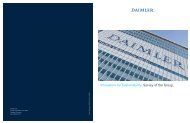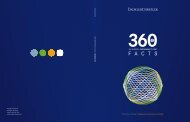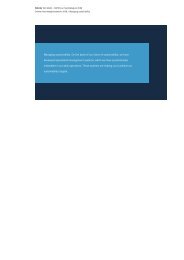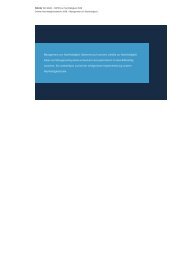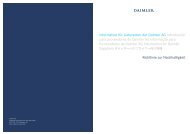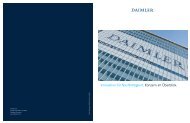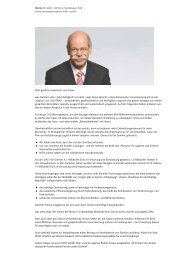Dear readers, This report describes what Daimler means by ...
Dear readers, This report describes what Daimler means by ...
Dear readers, This report describes what Daimler means by ...
Create successful ePaper yourself
Turn your PDF publications into a flip-book with our unique Google optimized e-Paper software.
<strong>Daimler</strong> 360 GRAD - FAKTEN zur Nachhaltigkeit 2008<br />
<strong>Daimler</strong> Nachhaltigkeitsbericht 2008 / Environmental protection, innovation, and safety / Products and product use /<br />
Fuel consumption and CO 2 emissions<br />
<strong>Daimler</strong> CAFE* values for passenger cars and light trucks 1996 – 2007 in the U.S.<br />
In the U.S., the Corporate Average Fuel Economy (CAFE) standards set the legal framework for improving energy<br />
efficiency. According to these standards, manufacturers’ passenger car fleets are weighted in line with sales. For<br />
model year 2008, they must have average values below 8.6 liters per 100 kilometers (27.5 miles per gallon) for<br />
cars, and 10.6 liters per 100 kilometers (22.2 miles per gallon) for light trucks. Standards for both passenger<br />
cars and light trucks have been tightened in the U.S. in recent years. As a result, the requirements will gradually<br />
be increased in the period between 2011 and 2020 to an average of 6.7 liters per 100 kilometers (35 miles per<br />
gallon).<br />
Average fuel economy for each model year is determined <strong>by</strong> the number of vehicles sold and the fuel economy<br />
value for each. Manufacturers that fail to achieve the set economy value must pay US $5.50 per every 0.1 miles<br />
per gallon they fall below the standard. Last year, the Group thus had to pay penalties totaling US $30.3 million<br />
for slightly more than 200,000 Mercedes vehicles imported into the U.S. <strong>by</strong> Mercedes-Benz in 2006, due to the<br />
fall in the number of FlexFuel vehicles in connection with model realignment measures.<br />
In Japan the “Top Runner” concept has fixed binding upper limits for fuel consumption from 2010 on for nine<br />
passenger car classes grouped according to gross vehicle weight. <strong>This</strong> standard will be extended to 16 car<br />
classes in 2015. The targets for 2010 have already been achieved in two vehicle classes.<br />
With long-distance trucks like the Mercedes-Benz Actros, <strong>Daimler</strong> has been leading the field for years in terms of<br />
fuel economy. Refined and even more efficient engines, improvements to tires and aerodynamic properties,<br />
variable axle drive ratios, and the introduction of BLUETEC technology have all led to substantial reductions in<br />
the fuel consumption of our commercial vehicles over the last few years. Orion VII hybrid buses, for example,<br />
consume up to 45 percent less fuel than conventional diesel buses, while the Mitsubishi Fuso Canter Eco Hybrid<br />
consumes 20 percent less fuel than a conventional truck.<br />
Impact of driving style on fuel consumption. Studies have shown that when a driver tries to anticipate events and<br />
drives with economy in mind, he or she can achieve fuel savings of as much as 10 percent over the long term.<br />
Exploiting such savings potential is the goal of the eco-training courses offered <strong>by</strong> Mercedes-Benz to drivers of<br />
both passenger cars and commercial vehicles.



